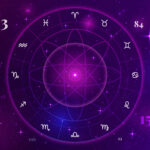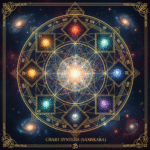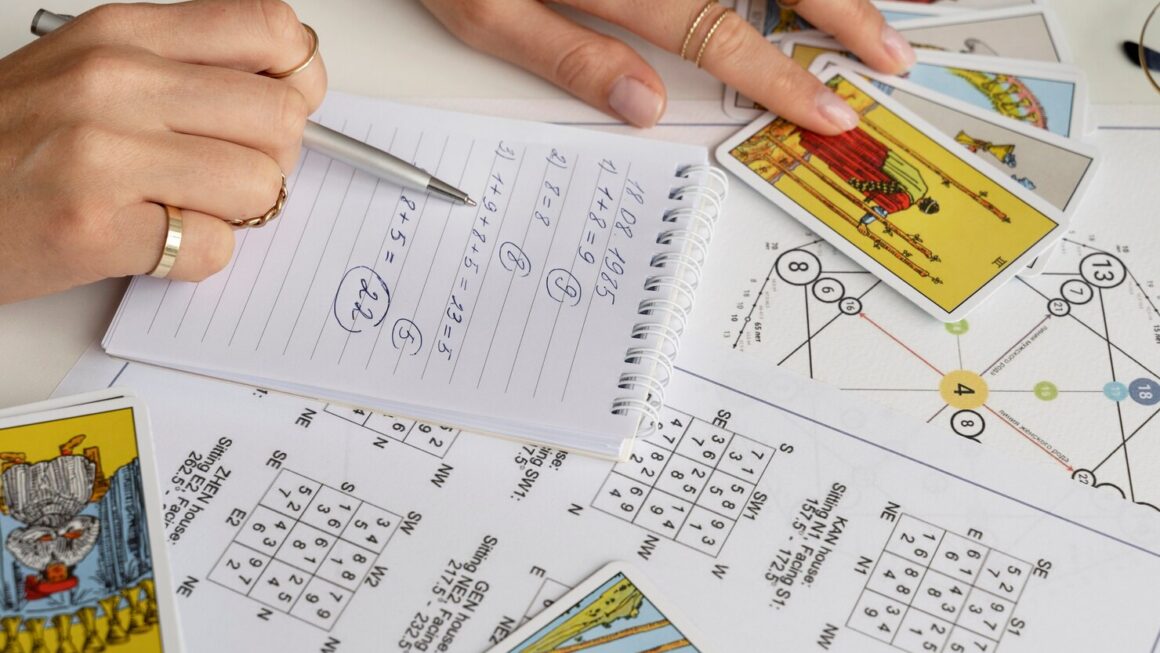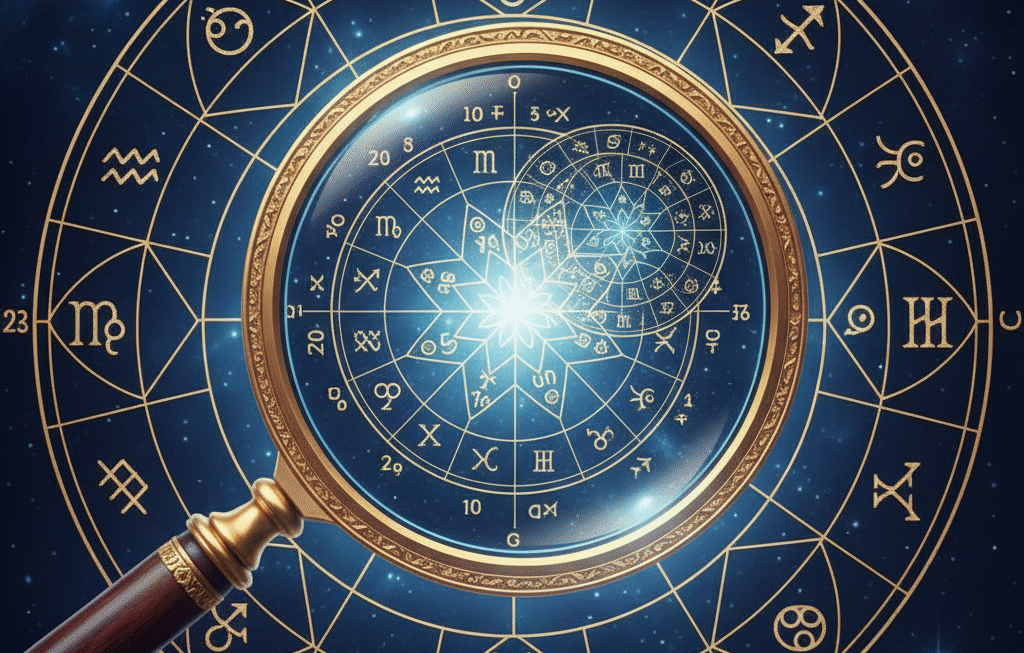What is the single most important map in Vedic astrology (Jyotish)? While the system utilizes numerous intricate charts and calculations, the absolute cornerstone, the very foundation upon which all analysis rests, is the primary birth chart itself. Known as the Rasi Chart D1 chart, this is the fundamental blueprint of an individual’s life, capturing the precise celestial alignment at the moment of their first breath.
Understanding its structure and significance is the essential first step before exploring any deeper layers of astrological interpretation. This guide introduces the foundational Rasi Chart D1, explaining its construction, its core meanings, and why it remains the indispensable starting point for unlocking the secrets of a horoscope.

Main Birth Chart: Unveiling the Cosmic Snapshot
Before diving into the complexities of divisional charts (Vargas) or intricate planetary periods (Dashas), we must first grasp the significance of the primary map. What exactly is this main birth chart? It is a celestial snapshot, a precise map of the heavens as seen from the exact time and location of your birth. It divides the 360-degree belt of the zodiac into 12 equal sections, known as signs (Rasis), and further divides the sky into 12 sections based on the horizon, known as houses (Bhavas).
The chart then plots the positions of the nine key celestial bodies (Grahas) – the Sun, Moon, Mars, Mercury, Jupiter, Venus, Saturn, and the lunar nodes Rahu and Ketu – within these specific signs and houses. The most critical point is the Ascendant (Lagna), the exact degree of the zodiac rising on the eastern horizon at the moment of birth, which determines the starting point of the house cusps.
The Core Significance of the D1 Chart Vedic Astrology
(Opinion): The Rasi Chart (D1) is the absolute bedrock of any Vedic astrological reading. It represents the physical manifestation of an individual’s karma, the tangible reality of their body, personality, environment, and the broad potential of events that will unfold throughout their life. It is the primary stage upon which the drama of life plays out.
(Reason): Why is the D1 chart vedic astrology places so much emphasis on considered so fundamental? Because it maps the literal, observable positions of the planets against the backdrop of the zodiac signs at the precise moment life begins. This configuration reflects the gross level of reality – the physical body, the immediate environment, the tangible opportunities and challenges one encounters.
The houses represent the different arenas of life (health, wealth, relationships, career, etc.), the signs represent the quality or nature of those arenas, and the planets represent the energies or actors operating within them. The Rasi chart shows the promise, the potential, the physical circumstances, and the overall trajectory. It is the “body” of the horoscope, the tangible structure.
(Example): A strong Sun placed in the 10th house in Aries in the D1 chart clearly promises the potential for a visible, authoritative career involving leadership and recognition. Conversely, a weak, afflicted Moon placed in the 8th house in Scorpio in the D1 chart promises potential challenges related to emotional well-being, hidden anxieties, or sudden emotional upheavals.
These are the broad-stroke potentials visible on the surface map. The actual quality, depth, and specific manifestation of these promises require deeper investigation (through Vargas), but the initial indication arises here, in the main chart.
(Opinion/Restatement): Therefore, the rasi chart d1 is the indispensable starting point, the foundational map that outlines the terrain of a lifetime. All subsequent analysis, including the assessment of divisional charts, yogas, and planetary periods, must be interpreted in relation to and supported by the core structure revealed in this primary chart.
Key Components of the Rasi Chart (D1)
(Pattern Spotting): To effectively read the Rasi chart, one must understand its key building blocks:
- The Houses (Bhavas): The chart is divided into 12 houses, starting from the Ascendant (Lagna) as the 1st house and proceeding counter-clockwise (in North Indian charts). Each house represents specific areas of life:
- 1st: Self, personality, physical body, health, vitality.
- 2nd: Wealth, family, speech, food, early learning.
- 3rd: Siblings, courage, communication, short journeys, skills.
- 4th: Mother, home, property, vehicles, emotional happiness.
- 5th: Children, intellect, creativity, speculation, past life merit.
- 6th: Enemies, debts, disease, obstacles, service.
- 7th: Spouse, partnerships, public image, desires.
- 8th: Longevity, obstacles, hidden matters, inheritance, transformation.
- 9th: Father, Guru, fortune, higher education, long journeys, dharma.
- 10th: Career, status, public action, achievements, karma.
- 11th: Gains, income, friends, network, fulfillment of desires.
- 12th: Loss, expenses, isolation, foreign lands, liberation (Moksha).
- The Signs (Rasis): The 12 zodiac signs overlay the houses, starting with the sign containing the Ascendant degree in the 1st house. Each sign imparts its unique quality or “flavor” to the house it occupies and the planets within it (e.g., fiery Aries, earthy Taurus, airy Gemini, watery Cancer).
- The Planets (Grahas): The 9 Grahas are the dynamic energies acting within the framework of the houses and signs. Each planet has natural significations (e.g., Sun = authority, Moon = mind, Mars = action) and functional roles based on the houses it rules for that specific Ascendant.
- The Ascendant (Lagna): This is the single most important point in the birth chart d1. It represents the native’s core identity, physical manifestation, and the lens through which they experience the world. The sign rising sets the house rulerships for the entire chart, and the strength of the Ascendant and its ruling planet (Lagna Lord) is paramount for overall life potential.
What the Rasi Chart D1 Primarily Reveals
(Value): So, what specific information can we glean directly from analyzing the Rasi Chart D1? It provides crucial insights into the tangible aspects of life:
- Physical Constitution and Health: The Lagna, Lagna Lord, Sun, and Moon in the D1 reveal the native’s inherent physical vitality, potential health vulnerabilities, and overall constitution.
- Core Personality and Temperament: The Lagna sign and lord, the Moon sign, and planets influencing the Lagna strongly indicate the fundamental nature, appearance, and behavioral tendencies of the individual.
- Major Life Themes and Overall Potential: The placement of house lords, the strength of planets in Kendras (1, 4, 7, 10) and Trikonas (1, 5, 9), and the presence of major Yogas in the D1 outline the broad trajectory and potential highs and lows of the life path.
- Tangible Circumstances: The D1 chart reflects the concrete realities of life – family background (2nd/4th/9th), educational environment (4th/5th), career path (10th), marital situation (7th), financial status (2nd/11th).
- The “Promise” of Yogas: Powerful combinations like Raja Yogas, Dhana Yogas, Mahapurusha Yogas, or challenging Arishta Yogas show their potential for manifestation in the physical world through their structure in the D1 chart.
The rasi chart d1 essentially describes the “hardware” and the basic “operating system” you are born with, and the main stage upon which your life’s events will physically unfold.
Mythbusting: Why the Rasi Chart D1 Isn’t the Whole Story
(Engagement): Here lies a crucial point often missed by beginners, leading to inaccurate predictions. While the Rasi Chart D1 is foundational, it is absolutely not the complete picture. You might see an incredibly strong D1 chart – exalted planets in Kendras, powerful Yogas – yet the person struggles significantly in a specific area, like career or marriage. Conversely, a seemingly weak or afflicted D1 chart might belong to someone remarkably successful and happy. Why?
The Rasi chart shows the potential and the physical manifestation, but it doesn’t always reveal the intrinsic quality, the underlying strength, or the specific nuance related to different facets of life. This deeper layer of information is hidden within the Divisional Charts (Vargas).
Think of the Rasi chart (D1) as a magnificent Mango tree. It looks healthy and strong (a good D1). It promises fruit. But will the actual mangoes be sweet, large, and perfectly formed, or will they be small, sour, or diseased? To know the quality of the fruit, you need to look deeper, and that’s what the Vargas do.
- The Navamsa (D9) chart reveals the underlying quality or “fruit” of all planets and promises, especially concerning marriage and dharma. A planet strong in D1 but weak in D9 is like a beautiful-looking tree that produces poor fruit. Its promise is superficial.
- The Dasamsa (D10) chart reveals the true quality and potential related specifically to career and achievement. A strong career promise in D1 needs confirmation of strength in D10 to manifest fully.
- Other Vargas like the Saptamsa (D7) for children or the Chaturthamsa (D4) for property provide similar specific insights.
This is why solely relying on the d1 chart vedic analysis often leads to frustration. The Rasi might show the potential for a Raja Yoga, but if the involved planets are severely debilitated in the Navamsa (D9) and Dasamsa (D10), the person might attain a position but lack the true quality of leadership or face significant struggles and downfall in their career. The promise seen on the surface (D1) is undermined by the weakness at the core (Vargas).
Conclusion: The Indispensable Foundation
The Rasi Chart (D1) remains the absolute cornerstone of Vedic astrological interpretation. It is the main birth chart, the fundamental map outlining our physical existence, core personality, major life potentials, and the tangible stage for our karmic journey. No accurate analysis can begin without a thorough understanding of the D1 chart’s structure – the Ascendant, the houses, the signs, the planets, and the Yogas formed within it.
However, recognizing its foundational role also means acknowledging its limitations. The Rasi chart paints the broad strokes, the promise, the potential. To understand the intricate details, the true quality, and the specific manifestation of that potential in different areas of life, we must look beyond the surface.
The birth chart d1 is the essential starting point, the body of the horoscope, but the soul, the depth, and the key to unlocking nuanced prediction lie in the synthesis of the D1 with the wisdom revealed in the Divisional Charts (Vargas) and the timing indicated by the Dasha system. It is the indispensable first chapter in the complex and fascinating story of a life written in the stars.











